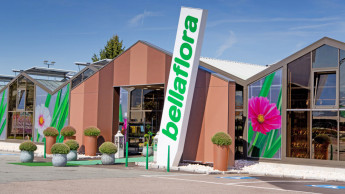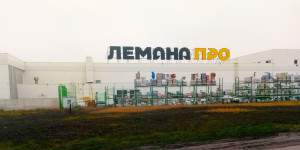For a long time the DIY stores in Austria tended to underestimate the significance of garden centres
Bellaflora, the Austrian garden centre multiple, had already opened several locations at this juncture, and accelerated development from then on. Dehner, the German market leader in terms of authentic garden centres, started up relatively cautiously after 1995 with well frequented locations in the vicinity of large-format DIY stores. In the mid-nineties Starkl, Austria’s biggest tree nursery, which is also active nationwide, already had garden centres linked to its nursery business, and separate ones in Vienna.
The definition of a garden centre has so far been analogous to Germany’s: a minimum 400 m² of weighted retail area, or from around 700 m² of actual space indoors and out. With the exception of Praktiker and Quester, all the DIY groups operating in Austria have garden centres, even though that is not true for all members of voluntary groups or all branches. The 185 garden centre outlets represent 45 per cent of the overall total of DIY stores. The weighted garden centre space of 396 000 m² corresponds to 21 per cent of the combined retail area of 1 276 000 m² (status: 31 December 2005).
Garden centres of DIY stores
According to a new survey of DIY stores and garden centres, AFS/RWA was found to have 29 outlets with 22 400 m² of weighted floorspace (790 m² on average). The Bauhaus garden centres are primarily to be found with the group’s ten large-format DIY stores and are correspondingly large (1 990 m² on average). Baumax installed garden centres at 85 per cent of its Austrian DIY stores, but in a very large format only in the case of its Mega DIY stores (1 725 m² on average). The Hagebau/Öbau group has quite a large number (33) of relatively small garden centres belonging to members (average retail area 910 m²). Hornbach’s large-format DIY stores are designed with big garden centres of 2 755 m² on average, including a pet department, on every location. The majority of Obi’s members (84 per cent) also have medium-sized garden centres (1 575 m² on average); the five large-format Obi DIY stores have weighted areas of 2 000 m² to 3 000 m².
Stand-alone garden centres
Bellaflora was represented by 22 outlets in seven Austrian states by the end of 2005, with the greatest emphasis on Lower and Upper Austria. With actual areas of approx. 5 000 m², the weighted retail areas must be around 3 400 m². In advertising promotions, Bellaflora calls itself the “Green Number 1”. Over the past ten years Germany's garden centre market leader, Dehner, has opened eight large garden centres with an average weighted retail area of 5 000 m² in Austria. The outlets are mainly to be found in larger cities or on the outskirts of these cities in six different federal states. The four outlets of Starkl, the tree nursery business, have already been mentioned in the introduction. There are of course, in addition to these 34 genuine garden centres, a great number of one-off local garden centres, often linked to market gardens or tree nurseries, though it is not known how many in total.
Regional breakdown
Taking the total of 3.340 mio households in Austria (2001 census), there are 1.557 mio detached houses or buildings (with 1.809 mio dwellings). Around 95 per cent of these detached houses have private gardens, but the total number of private gardens is considerably higher. There are no official statistics here: the number can be calculated or estimated only from representative studies by market survey institutions. According to information provided by households in various studies on the subject of garden ownership or leasing, the number of gardens can be put at 1.970 mio. Which means that at least 413 000 gardens (21 per cent) are not attached to an individual house. They are gardens in allotment schemes, by bathing ponds or the shores of lakes, gardens belonging to farms (as agricultural businesses) or allocated to individual tenants of multiple-occupancy buildings.
The regional distribution of gardens does not correspond to the distribution of the population or of households over the different federal states. The way the gardens are distributed throughout the states is rather comparable with the way the garden centre space is shared over the regions, with noticeable discrepancies in Vienna and western Austria.
An estimate of the garden centre area density in the individual states was undertaken by basing calculations on the existing households as recorded by the official Austrian statistics for each state. There are 8.5 households to 1 m² of garden centre area (weighted) in Austria. Lower Austria (dark green) has a significant area density, in conformity with the high number of detached houses as principal or secondary residences and the still considerably higher number of gardens in this state with a high proportion of flat land. The garden centre area density in Styria and Carinthia is also above-average. Many extremely large gardens can be found in the flat regions of Styria (light green). In Burgenland and Upper Austria the area density of garden centres corresponds to the average for Austria. In both of these states, very many of the detached houses function as secondary residences, and many Viennese citizens have their gardens in the lake-dominated region of Burgenland (light green).
The area density of garden centres in the western provinces of Tyrol and Vorarlberg is below-average in relation to the households, the detached houses and the number of gardens (orange). Here the nursery gardens are probably more significant, and gardens in this mountainous region are relatively small. The province of Salzburg is again a special case: the garden centre area density is extremely low – as can also be ascertained for the DIY store area density – although the number of private gardens is surprisingly high (light yellow). As expected, an exceptional situation is evident when it comes to the federal capital of Vienna: the number of households is extremely high because of the many single households, in contrast to the very low number of detached houses. The great majority of the gardens enumerated by the households (owned or leased) are not located in the city but in Lower Austria, in Burgenland and the tourist areas of the other federal states. The garden centre area density is extremely low as a result (light yellow). As a general rule, the east-west divide shown by the garden centre area density has much to do with the geographical structure of Austria: eastern lowlands and western highlands.
Download: Garden centres in Austria (PDF-File)

 Menü
Menü















